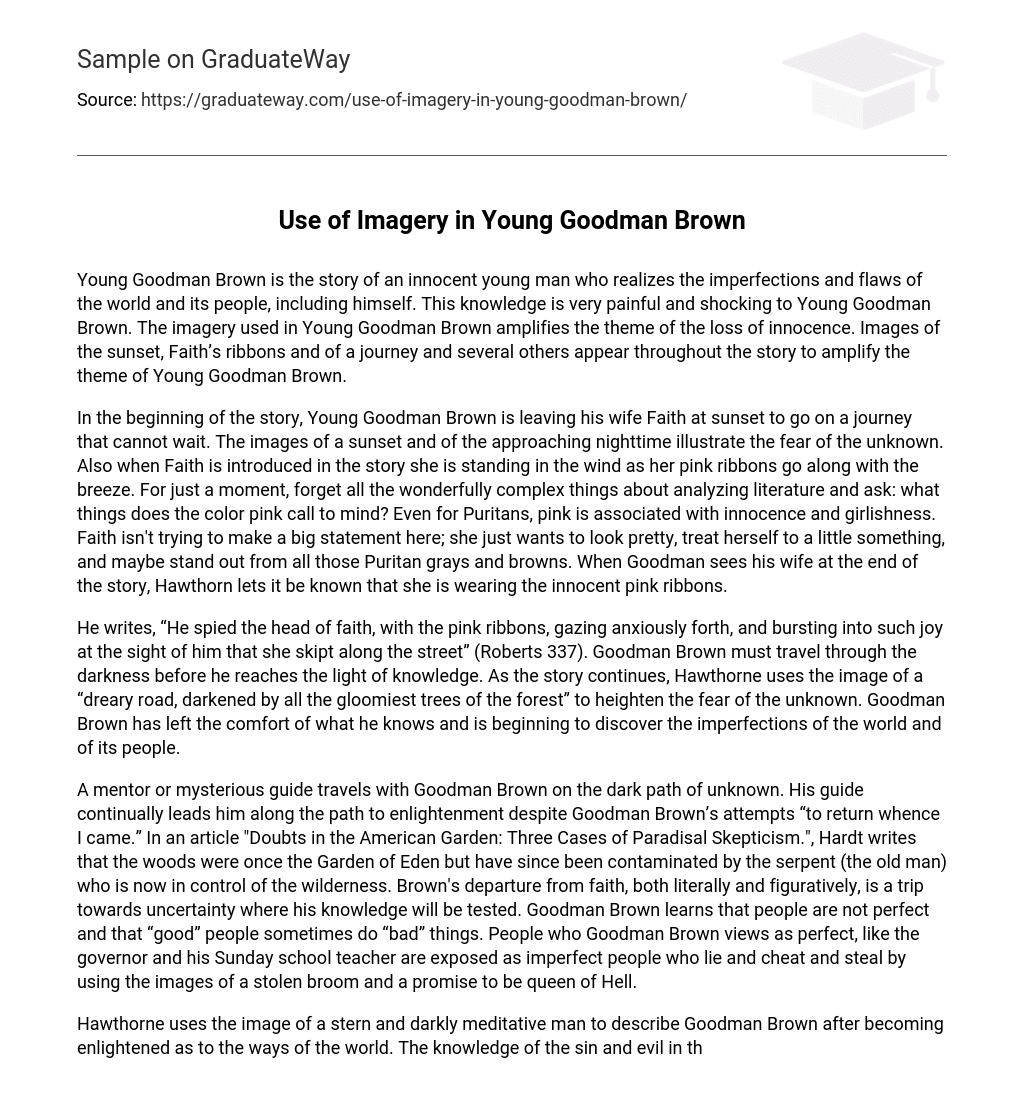Young Goodman Brown is the story of an innocent young man who realizes the imperfections and flaws of the world and its people, including himself. This knowledge is very painful and shocking to Young Goodman Brown. The imagery used in Young Goodman Brown amplifies the theme of the loss of innocence. Images of the sunset, Faith’s ribbons and of a journey and several others appear throughout the story to amplify the theme of Young Goodman Brown.
In the beginning of the story, Young Goodman Brown is leaving his wife Faith at sunset to go on a journey that cannot wait. The images of a sunset and of the approaching nighttime illustrate the fear of the unknown. Also when Faith is introduced in the story she is standing in the wind as her pink ribbons go along with the breeze. For just a moment, forget all the wonderfully complex things about analyzing literature and ask: what things does the color pink call to mind? Even for Puritans, pink is associated with innocence and girlishness. Faith isn’t trying to make a big statement here; she just wants to look pretty, treat herself to a little something, and maybe stand out from all those Puritan grays and browns. When Goodman sees his wife at the end of the story, Hawthorn lets it be known that she is wearing the innocent pink ribbons.
He writes, “He spied the head of faith, with the pink ribbons, gazing anxiously forth, and bursting into such joy at the sight of him that she skipt along the street” (Roberts 337). Goodman Brown must travel through the darkness before he reaches the light of knowledge. As the story continues, Hawthorne uses the image of a “dreary road, darkened by all the gloomiest trees of the forest” to heighten the fear of the unknown. Goodman Brown has left the comfort of what he knows and is beginning to discover the imperfections of the world and of its people.
A mentor or mysterious guide travels with Goodman Brown on the dark path of unknown. His guide continually leads him along the path to enlightenment despite Goodman Brown’s attempts “to return whence I came.” In an article “Doubts in the American Garden: Three Cases of Paradisal Skepticism.”, Hardt writes that the woods were once the Garden of Eden but have since been contaminated by the serpent (the old man) who is now in control of the wilderness. Brown’s departure from faith, both literally and figuratively, is a trip towards uncertainty where his knowledge will be tested. Goodman Brown learns that people are not perfect and that “good” people sometimes do “bad” things. People who Goodman Brown views as perfect, like the governor and his Sunday school teacher are exposed as imperfect people who lie and cheat and steal by using the images of a stolen broom and a promise to be queen of Hell.
Hawthorne uses the image of a stern and darkly meditative man to describe Goodman Brown after becoming enlightened as to the ways of the world. The knowledge of the sin and evil in the world is very disturbing and painful to Goodman Brown. Before his journey from the cave, he viewed the world as a kind, sunny place with green pastures and flowing rivers for him to run and swim in without being harmed. People were generous and kind and never did terrible things. When Goodman Brown is led from the forest to enlightenment, he realizes that people are capable of hurting each other and that the world can be a very dark place full of pain and terror caused by imperfect and insecure people. In an article, “Lachrymal Imagery in Hawthorne’s ‘Young Goodman Brown’”, Joan Easterly claims in her article that Goodman Brown is a changed man after his experience in the woods. She notes that Hawthorne demonstrates how Brown, a Puritan, fails the test of his moral and spiritual being. Easterly points out that Brown does not cry after realizing what he has witnessed at the witches’ commune. By not crying or realizing his inner emotions, Brown cannot progress morally or spiritually. This explains the symbolism that Hawthorne uses throughout the work. For example, the cold drops from the hanging twig as Brown awakes are not a Christian baptism since the water does not sprinkle on his head like in most Christian baptisms.
Knowledge is often painful. By using imagery, the theme of Hawthorne’s Young Goodman Brown is made more apparent to the reader. In a short article called “Cultural Fate and Social Freedom in Three American Short Stories.”, the writer Walter Shear states that at the end, Goodman Brown leaves the fantasy and returns to normal society. He is more aware of himself and of his relationship with other members of society. Shear says that Brown represents the unstable Puritanism as it decreases in its religious conviction and becomes somewhat hypocritical. Brown’s revulsion of his wife and community represents his own need to psychologically repress his reasons for taking the first step into the forest.





